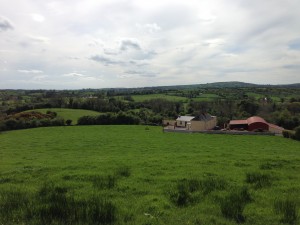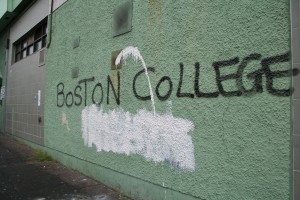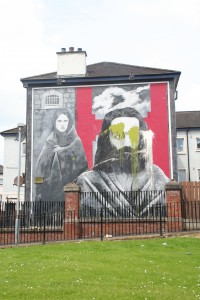… the more they change even more, I could add to the title of this post.
When I’m in Northern Ireland writing or setting up my DukeEngage program, I’m often preoccupied with the past. This year, I’ve been thinking about the 1800s a lot. In 1865, my great great grandfather, John Francis Brady, left the family farm on Murmod Hill, outside Virginia, County Cavan, and boarded a Philadelphia-bound ship. He married a Pennsylvania Dutch woman, Gertrude Barkley, and moved to Chicago, where many of my Brady relatives (including my mother) still live.
I was able to visit Cavan this year and even found what I think was the family farm, still with a traditional farm house (the area has been adopted by Dublin-based commuters, so the fact that I was even able to identify the place is exceptional). The experience definitely made me marvel at how little some things can shift in a century or more.
The farm was bought by the Dennings in the 1950s, and they raised their children there, all of whom still live in Ireland. I stopped to chat with Maureen Denning, now in her 80s, and she remembered when some Brady relatives had visited back in the 1970s. Her daughters Mairead and Rosetta stopped by for a chat on a rare sunny day. My family lore has it that the Americans who visited were stunned by the poverty. But when I visited, the place was all comfort and charm, set in the emerald landscape and with a fresh breeze coming from the regions many lakes.
The more things change, the more they change!
In Belfast, one can easily me deceived by how familiar things seem (to an occasional traveller like me). Black Mountain looms over West Belfast. It rains, then clears a bit, then rains and rains and rains. The Troubles murals draw dozens of tour busses a day, and the centuries-old issues — Orange vs. Green, flags and parades, who did what to whom again and again — get tiresome fast. Yet things have changed dramatically, with an often dizzying speed.
Painted across the familiar murals are references to the current dispute over the interviews with Troubles figures collected by Boston College and its researchers. In a nutshell, the College guaranteed interviewees that whatever they said would be kept confidential and wouldn’t result in any criminal charges.
But former IRA activists who were interviewed apparently claimed on tape that Gerry Adams, president of the Sinn Fein party and a former IRA member, ordered the 1972 death and secret disappearance of mother of ten Jean McConville. Those guarantees were exposed as meaningless and Adams was recently and very publicly called in for questioning by police.
Adams has always denied involvement in McConville’s kidnapping, killing and covert burial. Currently, Northern Irish police are awaiting the receipt of all of the interviews, which have formally been requested (and everyone assumes they will be released).
On the Catholic/Nationalist/Republican Falls Road, the anger is visible on the city’s spattered walls. The whited-out portion is likely the word “touts,” meaning informers, and is an attack on the lead researchers, a former IRA member and a journalist.
Interestingly, on my visit with students last weekend to Derry/Londonderry (often called “Stroke City,” for the stroke in the middle that distinguishes the way Catholics/Protestants refer to the place), most of the street graffiti we saw also revealed deep divisions not between communities, but within the Catholic/Nationalist/Republican community. Derry is a focus of dissident Republicans, who oppose the 1998 Good Friday agreement and want to return to what would likely be a violent campaign for unification with the Republic of Ireland.
When I was in Derry last summer, the murals were as striking as always. Late in the summer, however, dissidents pelted The Hunger Striker with green paint, a meaningful symbol (green=united Ireland and is reflected on the Irish flag). As Bogside artist Tom Kelly explained to us, the hunger striker depicted is former IRA man and now Sinn Féin politician and Derry native Raymond McCartney, who was taken off the strike after 53 days by his family. He was in prison for two murders, one of a police officer. Like others in a similar situation, he was released as part of the 1998 peace agreement and now represents Derry in the Northern Irish parliament.
Kelly believes that the mural was defaced by “real” IRA members who want to scuttle the peace. (they were also credited with the fire bomb thrown into a local hotel the day before we arrived, likely the result of that hotel’s hosting of a police recruitment drive.) McCartney is also a controversial figure for other reasons, so the artists are currently raising funds to repair the mural, paint over McCartney’s face and redesign the images.
The overwhelmingly Catholic Bogside supports peace, Kelly assured us. In fact, a large number of Northern Ireland’s Catholics prefer to remain part of the United Kingdom (38 percent according to a 2013 poll). That’s a huge shift all by itself.
But small groups can always make a big splash through violence. The effects of that are evident throughout the Bogside, where the number of “32 county” flags and dissident graffiti was worrisome.
Maybe things haven’t changed so much after all…




